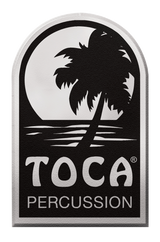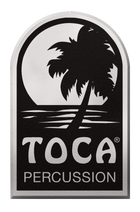Tips and Advice
Tuning and Maintenance of Toca Congas
Tuning
Toca Congas come with high-grade bison skin heads matched in thickness to the size of each drum. Your drums will need to be tuned, as they do not come pre-tuned from the factory.
Congas are approximately 28 to 30 inches tall and vary in diameter from 9 to 13 inches. The smallest drum is called the quinito, which varies in size from 9.5 to 10.5 inches in diameter across the playing surface. The conga or segunda varies in size from 10.5 to 11.5 inches, and the tumba or tumbadora varies from 11.5 to 13 inches in diameter. All the above instruments are commonly referred to as "congas" but as you can see, they are each different in size and tonality.
The drums should be tuned to the middle range for the best tone and volume. The quinito should be tuned from D at the lowest to the A above, depending on the size. The conga or segunda should be tuned from C to the E above, depending on the diameter size. The tumba should be tuned from an A to the B above, depending on size.
To obtain these pitches, you should first determine the size of your drum by the diameter of the playing surface. Using a tuning wrench, start at the tuning rod closest to the Toca logo. Moving in a circular motion around the drum, (using the Toca logo as your guide to remember where you started) give each nut one half turn in a counter-clockwise direction until you've gone around the drum once completely. Tightening in half turns is recommended for applying even tension to the head. If the head is very loose, more turns can be used to get the head to produce a tone. Continue this process until the desired pitch is reached, always keeping in mind to visually inspect the collar of the head for even tension.
Remember that an animal skin head is not perfectly even like a plastic head. Therefore, the drum will never be perfectly tuned, as the skin may be heavier on one side than the other. If you tune the drum while it is sitting on the floor and then place the drum on a stand, you will notice that the pitch will rise. This must be taken into consideration while tuning.
Maintenance
- It is a good idea to slightly loosen your heads after playing. Going in a circular motion, give each tension nut a half turn clockwise to loosen. Do this, working your way completely around the drum twice. This simple procedure will help to lengthen the life of your heads.
- During the manufacturing process, (before skin heads are mounted to the drums) heads are soaked in water to make them pliable for mounting. Due to this process, some of the oils are depleted from the heads. To achieve the best possible sound, we recommend rubbing a small amount of hand lotion containing lanolin into your drum head, once they have been tuned. This will make the skins sound better, increasing volume and tonality, because the skin can relax to vibrate better.
- Occasionally the tension rods will squeak when tightening or loosening. This occurs when the lubricant between the nuts and washers dries up. If this occurs apply some lug lube.
- You can keep fingerprints off your shell with a chamois polish cloth.
- When putting on a new bison conga head it is a good idea to turn the head upside down and fill the inside with 1/2" of cold water. Let soak for two to three hours. This will make the head more pliable and will make it seat on the bearing edge. Tighten the head until there is no valley on top and it is even all the way around. Let sit overnight and tune with method described above.
Tuning and Maintenance of Toca Bongos
Tuning
Toca Bongos come with high-grade bison skin heads matched in thickness to the size of each drum. Your drums will need to be tuned, as they do not come pre-tuned from the factory.
When tuning bongo drums, they should be pitched as close to an octave apart as possible. The most popular tuning is A octave, but this usually depends on the type of skins. Plastic heads are available for certain models of bongo drums, but animal skins are preferred. There should be a thinner skin on the small drum and a medium skin on the large drum.
To obtain these pitches, you should first determine the size of your drum by the diameter of the playing surface. Using a tuning wrench, start at the tuning rod closest to the Toca logo. Moving in a circular motion around the drum, (using the Toca logo as your guide to remember where you started) give each nut one half turn in a counter-clockwise direction until you've gone around the drum once completely. Tightening in half turns is recommended for applying even tension to the head. If the head is very loose, more turns can be used to get the head to produce a tone. Continue this process until the desired pitch is reached, always keeping in mind to visually inspect the collar of the head for even tension.
There are many different tuning possibilities depending on the playing situation. We recommend the following tunings, which can be achieved by using a piano keyboard.
- Macho B - D two octaves above middle C
- Hembra A two octaves above middle C
Maintenance
- It is a good idea to slightly loosen your heads after playing. Going in a circular motion, give each tension nut a half turn clockwise to loosen. Do this, working your way completely around the drum twice. This simple procedure will help to lengthen the life of your heads.
- During the manufacturing process, (before skin heads are mounted to the drums) heads are soaked in water to make them pliable for mounting. Due to this process, some of the oils are depleted from the heads. To achieve the best possible sound, we recommend rubbing a small amount of hand lotion containing lanolin into your drum head, once they have been tuned. This will make the skins sound better, increasing volume and tonality, because the skin can relax to vibrate better.
- Occasionally the tension rods will squeak when tightening or loosening. This occurs when the lubricant between the nuts and washers dries up. If this occurs apply some lug lube.
- You can keep fingerprints off your shell with a chamois polish cloth.
- When putting on a new bison conga head it is a good idea to turn the head upside down and fill the inside with 1/2" of cold water. Let soak for two to three hours. This will make the head more pliable and will make it seat on the bearing edge. Tighten the head until there is no valley on top and it is even all the way around. Let sit overnight and tune with method described above.
Tuning and Maintenance of Toca Timbales
Tuning
Toca timbales come with high quality plastic heads. Your timbales will need to be tuned as they do not come pre-tuned from the factory. First, assemble drums on the stand. Use tuning wrench or drum key depending on the model timbale set you have and remove any ripples in the head that may appear. Pick a tension rod to start at and give it a turn counter clockwise. Do this to all tension rods, moving in a clockwise direction until you reach the point that you started from. Continue this process until you obtain the desired pitch. Once the desired pitch is achieved, tap the head 1" in from each lug to get the head in tune with itself.
**There are many different tuning possibilities depending on your preference. The interval of a perfect fourth between the two drums is the most common tuning, however drums can also be tuned to the interval of a perfect fifth.
We recommend the following tunings using a piano keyboard.
- Macho F 1 octave above middle C - A
- Hembra C 1 octave above middle C - E
Tuning and Maintenance of Toca Djembes & Doumbeks
Tuning
Toca's Djembes and Doumbeks will need to be tuned as they do not come pre-tuned from the factory.
With a tuning wrench, move in a circular motion around the drum, (using the Toca Logo as your guide to remember where you started) giving each nut one half turn in a counter-clockwise direction until you've gone around the drum once completely. Tightening in half turns is recommended for applying even tension to the head, (if the head is very loose, more turns can be used to get the head to produce a tone). Continue this process until the desired pitch is reached, always keeping in mind to visually inspect the collar of the head for even tension.
It is important to note that the animal skin head is matched to the size of your drum. Animal skin heads are not perfectly even like plastic heads. Drums should be tuned until the pitch is high and focused, with no ring while playing an open tone.
Maintenance
- It is a good idea to slightly loosen your heads after playing. Going in a circular motion, give each tension nut a half turn clockwise to loosen. Do this, working your way completely around the drum twice. This simple procedure will help to lengthen the life of your heads.
- During the manufacturing process, (before skin heads are mounted to the drums) heads are soaked in water to make them pliable for mounting. Due to this process, some of the oils are depleted from the heads. To achieve the best possible sound, we recommend rubbing a small amount of hand lotion containing lanolin into your drum head, once they have been tuned. This will make the skins sound better, increasing volume and tonality, because the skin can relax to vibrate better.
- Occasionally the tension rods will squeak when tightening or loosening. This occurs when the lubricant between the nuts and washers dries up. If this occurs apply some lug lube.
- You can keep fingerprints off your shell with a chamois polish cloth.
- When putting on a new bison conga head it is a good idea to turn the head upside down and fill the inside with 1/2" of cold water. Let soak for two to three hours. This will make the head more pliable and will make it seat on the bearing edge. Tighten the head until there is no valley on top and it is even all the way around. Let sit overnight and tune with method described above.

